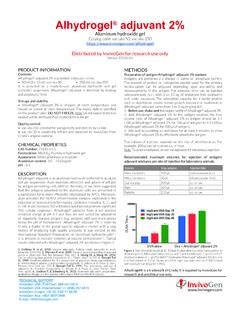Transcription of CELL CULTURE CONTAMINATION - InvivoGen
1 Protect your cellsMycoplasma contaminationsBacterial contaminationsEndotoxin contaminationsFungal contaminationsWhether remaining unnoticed or expanding rapidly, microbes can seriously alter cell morphology and functions, becoming a serious threat to your research. InvivoGen offers microbial detection tools and elimination reagents, as well as preventive CULTURECONTAMINATIONOV erview of microbial contaminantspractical guide151412105A PRACTICAL GUIDE TO AVOID CELL CULTURE CONTAMINATIONYOUR CELLS ARE PRECIOUS, PROTECT THEM!DetectionPreventionEliminationEndot oxin contaminationsWhat are endotoxin features?What are the risks for my experiments?Detection of endotoxins in biological reagentsFungal contaminationsHow to detect fungal CONTAMINATION in cell cultures? Elimination of fungiMYCOPLASMA contaminationsMycoplasma features & dangers Detection of mycoplasma contaminationElimination of mycoplasmaBacterial contaminationsThe usual suspects How to detect bacterial CONTAMINATION ?
2 Elimination of bacteriaSummary table of InvivoGen santimicrobial agentsREFERENCES4pAGEpAGEpAGEpAGEpAGEpAG E2 CFU : colony-forming unit DNA : deoxyribonucleic acid IRF : interferon regulatory factor kDa : kilodalton LAL : limulus amebocyte lysate LPS : lipopolysaccharideNF- B : nuclear factor kappa-light-chain enhancer of activated B cells PCR : polymerase chain reaction PRR : pattern recognition receptor rRNA : ribosomal ribonucleic acid SEAP : secreted embryonic alkaline phosphatase TLRs : toll-like receptorsAbbreviationsMicrobial CONTAMINATION of cell cultures is a serious and relentless threat to your research. Invasive mycoplasma, bacteria, and fungi can kill or drastically alter cells in CULTURE , leading to disastrous results, lost time, and wasted resources. This brochure provides an insight into the contaminants that are most likely to invade your cultures, the good practices to avoid them, and the solutions to eliminate them.
3 As experts in innate immunity and microbiology, we know how these biological contaminants can interfere with experimental results. While bacterial and fungal contaminations are eventually detected by the naked eye, mycoplasma and endotoxins remain invisible. Undetected contaminants are a serious concern, as they may have led to data misinterpretation, many of which have been published. As a consequence, journals now frequently ask for evidence of absence of mycoplasma and endotoxins in cell cultures. Moreover, pharmaceutical companies developing future therapeutics cannot afford contaminations as they will compromise their research and reputation. At InvivoGen , we strive for excellence. We provide high-quality products and mycoplasma-free cell lines all around the world.
4 This guide will help you address every stage of microbial infection, and choose the right InvivoGen product to detect, eliminate, and prevent contaminations in your cell >14 MYCOPLASMA IN NUMBERS95%1956 First detection and isolation of mycoplasma in cell cultures +180 Different mycoplasma species have been identified 20 AtLEASTD istinct mycoplasma species isolated from contaminated cell culturesof cell CULTURE CONTAMINATION is due to 6 mycoplasma species M. orale M. fermentans M. hyorhinis M. hominis M. arginini A. laidlawii80% oflab operatorscarry mBacteria1-10 mYeast3-10 mEukaryotic cell10-100 m15%of US LABSCONTAMINATED50%OF US LABSDO NOT TEST35%OF CONTAMINATION IN US and EUROPE CELL BANKS>60%CELL CONTAMINATIONIN ASIAWORLDWIDECONTAMINATIONANTI-MICROBIAL SPECIFIC REAGENTS &ASSAYS TO ACCOMPANY YOURSUCCESSFULRESEARCHM ycoplasma CONTAMINATION testing status must also be is good to obtain cell lines from reputable repositories.
5 To routinely authenticate cell line stocks and test them for mycoplasma contaminationCONTAMINATION PREVENTION TIPSQ uarantine all new cell cultures and animal products entering the laboratoryAvoid talking over your cells6% of operators spread mycoplasma by talkingAvoid sneezing38% of operators spread mycoplasma by sneezingAsk manufacturers for certification proving the absence of mycoplasma contaminationBe vigilant and always practice good aseptic techniqueRoutinely test your cellsOFFERSELECTRON MICROSCOPELIGHT MICROSCOPEEYESTINY ORGANISMS, BIG HEADACHESYOUR CELLS ARE PRECIOUS, PROTECT THEM!Elimination Typically, once invasive microbes are detected in cell cultures it is recommended to discard the cells and the media. However, some cell cultures are so precious that they cannot be lost ( stable clone selection, cell lines derived from explanted tissues, primary cells) and are not available elsewhere ( not yet frozen).
6 In such situations, InvivoGen provides antibiotics to eradicate the CONTAMINATION surely and rapidly without damaging your Microbial CONTAMINATION must be detected as early as possible. Detection methods depend on the nature of the microbe. They include biological assays, PCR, fluorescence or chemical staining, optical microscopy, turbidimetry, pH measurements, or simple visual inspection. Bacteria and fungi can usually be identified by optical microscopy. Their fast growth rate allows their detection by the naked eye as early as 48 hours ( over the weekend), the contaminated cultures appearing turbid or spotty. Subsequently, identification of these micro-organisms can be performed with testing kits. Mycoplasma in cell cultures cannot be detected visually, not even by optical microscopy.
7 Hence, these microbes can go unnoticed for long periods and are identified using dedicated assays. Prevention Knowing the sources of microbial CONTAMINATION is crucial for minimizing the risk to cell cultures (see below). Although absolute prevention is impossible, you can take various measures to prevent infection. Firstly, ensure that you are working in a sterile environment and using proper aseptic technique. Secondly, quarantine any incoming cell cultures until these have been confirmed free of CONTAMINATION . Thirdly, monitor your cell cultures for CONTAMINATION on a regular basis by optical microscopy and detection kits. Lastly, you can use antibiotic cocktails, such as those offered by InvivoGen , specifically designed for taking a preventive strike against microbes that would be difficult to detect in new cultures ( primary cells, or cloning).
8 1. INFRASTRUCTURE: Fume-hoods, ventilation units and laboratory furniture can house surface microorganisms and spread airborne ones. Clean working areas daily with alcohol and monthly with bleach. Regularly change all air filters, and empty all media traps at least OPERATOR: Laboratory staff can transmit microbes and dust from their skin, clothes and bodies to cell cultures. Wear proper safety garments and use aseptic PIPETTES, TIPS, SYRINGES & VACUUM PUMPS: A contaminated pipette can destroy multiple cell cultures. Use sterile pipettes, tips and syringes and never reuse disposables. Make sure to empty and clean the vacuum pump reservoir and tubings EQUIPMENT: Glassware, incubators and water baths can easily be contaminated. Keep all equipment sterile and frequently change the water in the baths, which are notorious for fungal infections.
9 Regularly disinfect all SAFETY GARMENTS: Labcoats and gloves must be clean and should be worn only in the lab. Use disposable garments only once and discard them immediately CULTURE MEDIA, REAGENTS & CELLS: Before using any CULTURE medium, reagent or cells, confirm that they are sterile. Carefully seal all sources of microbial CONTAMINATION in the laboratoryMYCOPLASMA CONTAMINATIONSM ycoplasma are the smallest and simplest self-replicating organisms. Because of their small size (100 nm) and lack of a rigid cell wall, mycoplasma are undetectable by visual inspection, pass through standard filtration, and are resistant to a large number of antibiotics1. Mycoplasma CONTAMINATION is a major problem in cell CULTURE , affecting the validity of experimental results as well as the quality and safety of cell-based biopharmaceuticals2.
10 Mycoplasma compete with host cells for nutrients and biochemical precursors. As a consequence, they alter many cell functions, such as cell metabolism and cell growth, ultimately leading to cell death. A microarray analysis on contaminated cultured human cells has revealed the severe effects that mycoplasma can have on the expression of hundreds of genes, including some that encode receptors, ion channels, growth factors, and oncogenes4. Upon adhesion or fusion with the host cell membrane, they can cause further damage to the cell by interfering with signaling cascades and cytokine production5. These detrimental effects can strongly impact scientific results and invalidate the findings of a study, especially when it involves immune cells expressing TLR2, such as macrophages3, belong to the class of Mollicutes, which members are distinguished by their lack of cell wall and their plasma-like form.



